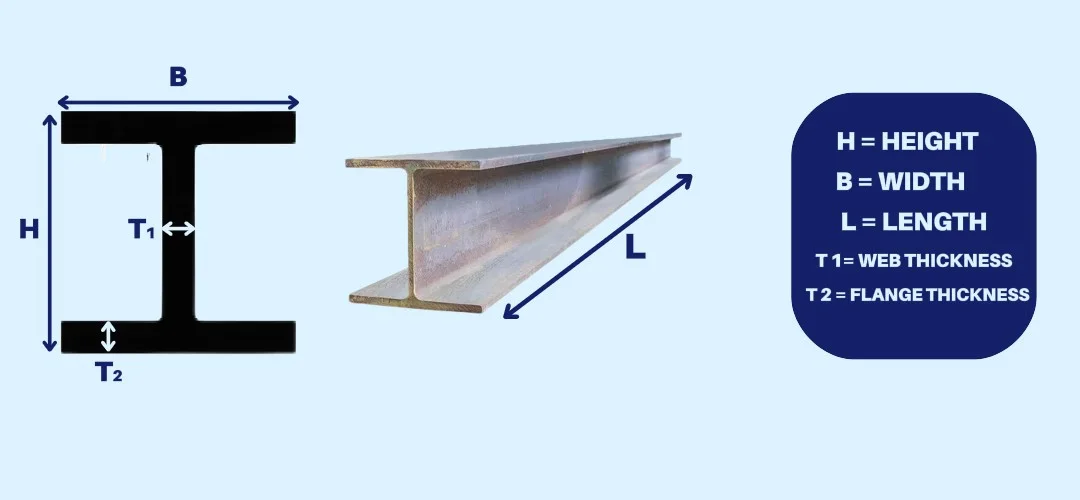
In structural engineering and construction projects, precision is paramount. Calculating the weight of H-beams—the backbone of modern steel structures—is critical for cost estimation, transportation planning, and structural integrity analysis.
Our H-Beam weight calculator provides engineers, architects, and fabricators with instant, accurate weight calculations for any H-beam configuration.
An H-Beam weight calculator is a specialized digital tool that computes the weight of H-shaped steel beams based on dimensional inputs and material properties.
Our calculator uses the industry-standard formula:Where:
H = Height of the web
t₁ = Web thickness
B = Flange width
t₂ = Flange thickness
This sophisticated tool eliminates guesswork from structural planning by automating complex calculations that traditionally required engineering handbooks and time-consuming manual computations.
Our H-Beam weight calculator stands out with these essential features:
12+ material options including Mild Steel, Stainless Steel, Aluminum, and Titanium
Pre-loaded density values per industry standards (e.g., 7850 kg/m³ for Mild Steel)
Supports mm, cm, m, inches, and feet
Automatic unit conversion
Real-time metric/imperial switching
Displays results in kilograms, pounds, metric tons, and grams
Visual formula breakdown
Error validation for all inputs
Height (H): Vertical web measurement
Width (B): Horizontal flange width
Web Thickness (t₁): Center vertical section thickness
Flange Thickness (t₂): Horizontal flange thickness
Length: Beam length
Choose from 12+ engineering materials with pre-configured densities.
Select preferred measurement units for each dimension.
Click “Calculate” for instant results across four weight units.
Accurate load calculations prevent over-engineering and ensure safety compliance.
Precise weight data enables accurate material costing (±0.5% margin).
Weight determines:
Vehicle selection
Route planning
Logistics costs
Optimize cutting plans and minimize material waste.
Unit conversion eliminates measurement errors in global collaborations.
Understanding the formula is crucial for professional validation:
Cross-Sectional Area = (H × t₁) + 2 × (B × t₂) – 2 × (t₁ × t₂)
The subtraction accounts for overlapping corner areas to prevent double-counting. Combined with material density and length, this yields precise volume-to-weight conversion.
Example Calculation:
H=200mm, B=200mm, t₁=10mm, t₂=15mm, Length=6m, Mild Steel
Area = (0.2 × 0.01) + 2×(0.2×0.015) – 2×(0.01×0.015) = 0.0085m²
Volume = 0.0085m² × 6m = 0.051m³
Weight = 0.051m³ × 7850kg/m³ = 400.35 kg
Reduces calculation time from 15+ minutes to 5 seconds.
Eliminates common mistakes:
Unit conversion errors
Formula misapplication
Decimal place inaccuracies
Digital results are easily shareable and reproducible.
Accurate foundation load calculations
Crane capacity verification
Raw material procurement
Production scheduling
Container space optimization
Freight cost forecasting
Our H-Beam weight calculator complies with:
AISC (American Institute of Steel Construction) standards
EN 10034 (European H-beam specifications)
ISO 657-1 (Hot-rolled steel sections)
Cross-verified against:
Manual calculations
CAD software outputs
Manufacturer data sheets
Margin of error: <0.25% under standard conditions.
Results are accurate within 0.25% when correct measurements are entered, verified against industry standards.
Yes! Supports aluminum, copper, titanium, and 9 other materials.
For precision-critical projects, add ±2% to cover mill tolerances per ASTM A6.
In an industry where structural miscalculations can cost thousands, our H-Beam weight calculator provides indispensable accuracy. By automating complex dimensional mathematics and material science conversions, this tool enables professionals to:
Generate instant quotes
Verify structural feasibility
Optimize material usage
Ensure regulatory compliance
Explore the Engineer’s Guidebook! Find the latest engineering tips, industry insights, and creative projects. Get inspired and fuel your passion for engineering.
© 2023-2024 Engineer’s Guidebook. All rights reserved. Explore, Innovate, Engineer.